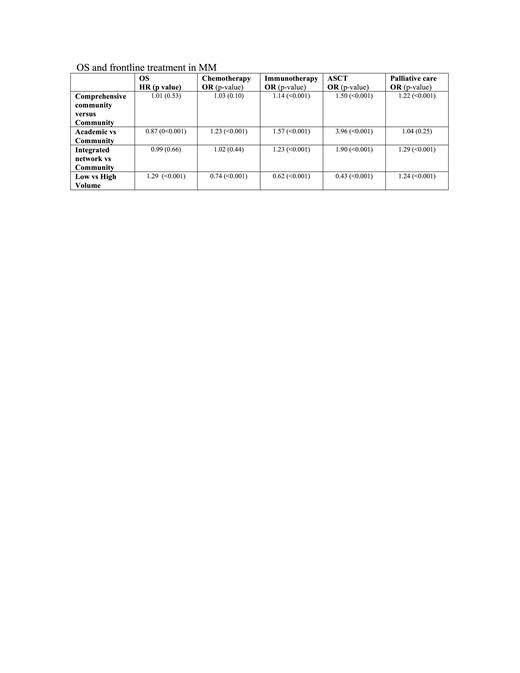Abstract
Introduction:
Prior studies have shown poorer outcomes in Black and Hispanic patients and in patients with lower median household income and education 1-5. In MM, we hypothesize that facility affiliation and case volume affects overall survival (OS) and rates of frontline treatment (including chemotherapy, immunotherapy, autologous stem cell transplant [ASCT] and palliative care).
Methods:
This is a retrospective analysis of 174,551 MM patients in the NCDB database, over the age of 18 years, between 2004-2016. Facility types include community cancer programs, comprehensive community cancer programs, academic/research cancer programs and integrated network cancer programs. High volume facilities had new MM cases per year ≥ 99 th percentile, and all other facilities were classified as low volume. Multivariable analyses used Cox proportional hazard analysis for OS and logistic regression for use of treatment, adjusted for age, sex, race, Hispanic origin, education, great circle distance, CCI score, and type of county (depending on population size). Kaplan-Meier method was used to estimate median OS, and the log rank test was used to compare OS across predictor variables.
Results:
The median age was 67 years (range 18-90) with 55% males, and 76% White vs 20% Black. In academic/research cancer programs, the median OS in high volume centers was 75.5 mo vs 50.2 mo in low volume centers (p<0.01). In community cancer programs, the median OS in high volume centers was 55.2 mo vs 35.5 mo in low volume centers (p<0.01). In multivariable analyses, the OS was higher in academic/research cancer programs vs community cancer programs (hazard ratio of 0.87 p<0.01). There was no significant difference in OS at integrated network cancer programs or comprehensive community cancer programs vs community cancer programs. The odds of utilizing chemotherapy were higher in academic/research cancer programs compared to community cancer programs (p<0.01 for both), whereas the odds of receiving palliative care were similar between both facility types (p=0.25). The odds of utilizing ASCT were higher in all facilities when compared to community cancer programs (p<0.01). The odds of utilizing palliative care were higher at integrated network cancer programs and comprehensive community cancer programs compared to community cancer programs (p<0.01 for both). Facilities with low volume of cases had significantly lower odds of utilizing chemotherapy, immunotherapy and ASCT when compared to high volume facilities; however had significantly increased odds of receiving palliative care.
Discussion:
Our results show that academic/research cancer programs with high volumes have the best OS in MM. Additionally, academic/research cancer programs are more likely to give chemotherapy, immunotherapy, and ASCT, but less likely to give palliative care. We theorize that academic/research cancer programs with a high volume of cases likely have increased resources, which optimizes outcomes. Given that ~25% of patients with MM die in the first year 6, there is a recognized need to identify strategies to improve early outcomes in patients treated at community cancer programs and low volume facilities.
Lai: Jazz Pharma: Consultancy, Membership on an entity's Board of Directors or advisory committees; Daiichi-Sankyo: Consultancy, Membership on an entity's Board of Directors or advisory committees; Astellas: Speakers Bureau; Macrogenics: Consultancy, Membership on an entity's Board of Directors or advisory committees; Agios: Consultancy, Membership on an entity's Board of Directors or advisory committees; AbbVie: Consultancy, Membership on an entity's Board of Directors or advisory committees; Jazz Pharma: Speakers Bureau; Genentech: Consultancy, Membership on an entity's Board of Directors or advisory committees.


This feature is available to Subscribers Only
Sign In or Create an Account Close Modal